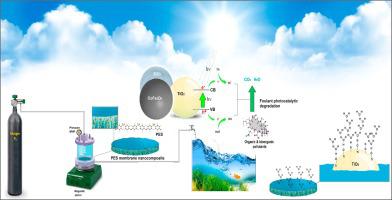当前位置:
X-MOL 学术
›
Sep. Purif. Technol.
›
论文详情
Our official English website, www.x-mol.net, welcomes your
feedback! (Note: you will need to create a separate account there.)
Preparation and characterization of a novel photocatalytic self-cleaning PES nanofiltration membrane by embedding a visible-driven photocatalyst boron doped-TiO2[sbnd]SiO2/CoFe2O4 nanoparticles
Separation and Purification Technology ( IF 8.1 ) Pub Date : 2018-09-11 , DOI: 10.1016/j.seppur.2018.09.030 Hadis Zangeneh , Ali Akbar Zinatizadeh , Sirus Zinadini , Mostafa Feyzi , Detlef W. Bahnemann
Separation and Purification Technology ( IF 8.1 ) Pub Date : 2018-09-11 , DOI: 10.1016/j.seppur.2018.09.030 Hadis Zangeneh , Ali Akbar Zinatizadeh , Sirus Zinadini , Mostafa Feyzi , Detlef W. Bahnemann

|
Novel self-cleaning PES nanofiltration membranes were successfully synthesized via the phase inversion method with different amounts of the boron doped-TiOSiO cobalt ferrite (B-TiOSiO/CoFeO) nanophotocatalyst. The nanofiltration performance was investigated by the rejection of direct red 16 and COD removal of the biologically treated palm oil mill effluent (POME). The addition of the B-TiOSiO/CoFeO nanoparticles into the polymeric casting solution improved porosity, morphology, structure, pure water flux (PWF), antifouling properties and separation performance of the embedded membranes due to hydrophilic behavior and photocatalytic properties of the B-TiOSiO/CoFeO nanoparticles. The B-TiOSiO/CoFeO nanoparticles can degrade adsorbed organic foulants on the membrane surface (reversible fouling) or deposited/trapped fouling agents into the membrane pores (irreversible fouling). The prevention of the interaction between organic foulant and hydrophilic membrane improves antifouling properties and wettability of the modified membranes. The membrane with 0.5 wt% of the B-TiOSiO/CoFeO nanoparticle had the highest pure water flux and flux recovery ratio (FRR) with the best separation performance. However, at high concentration of nanoparticles, agglomeration of the nanoparticles on membrane surface/pores resulted in pore blocking, roughness membrane surface which led to slightly reduction of PWF, FRR and separation performance. The obtained results were also confirmed by contact angle measurement, scanning electron microscopy (SEM) and atomic force microscopy analysis (AFM).
中文翻译:

嵌入可见光驱动光催化剂掺硼TiO2[sbnd]SiO2/CoFe2O4纳米粒子新型光催化自清洁PES纳滤膜的制备与表征
采用不同量的硼掺杂-TiOSiO钴铁氧体(B-TiOSiO/CoFeO)纳米光催化剂,通过相转化法成功合成了新型自清洁PES纳滤膜。通过直接去除红色 16 和去除生物处理的棕榈油厂废水 (POME) 的 COD 来研究纳滤性能。由于 B-TiOSiO2/CoFeO 纳米颗粒的亲水行为和光催化性能,将 B-TiOSiO/CoFeO 纳米颗粒添加到聚合物浇铸溶液中,改善了嵌入膜的孔隙率、形态、结构、纯水通量 (PWF)、防污性能和分离性能/CoFeO纳米颗粒。 B-TiOSiO/CoFeO 纳米粒子可以降解膜表面吸附的有机污染物(可逆污垢)或沉积/截留到膜孔中的污垢剂(不可逆污垢)。防止有机污染物与亲水膜之间的相互作用提高了改性膜的防污性能和润湿性。添加0.5 wt% B-TiOSiO/CoFeO纳米颗粒的膜具有最高的纯水通量和通量回收率(FRR),且分离性能最好。然而,在高浓度纳米粒子时,纳米粒子在膜表面/孔上的团聚导致孔堵塞,膜表面粗糙,导致PWF、FRR和分离性能略有下降。接触角测量、扫描电子显微镜(SEM)和原子力显微镜分析(AFM)也证实了所得结果。
更新日期:2018-09-11
中文翻译:

嵌入可见光驱动光催化剂掺硼TiO2[sbnd]SiO2/CoFe2O4纳米粒子新型光催化自清洁PES纳滤膜的制备与表征
采用不同量的硼掺杂-TiOSiO钴铁氧体(B-TiOSiO/CoFeO)纳米光催化剂,通过相转化法成功合成了新型自清洁PES纳滤膜。通过直接去除红色 16 和去除生物处理的棕榈油厂废水 (POME) 的 COD 来研究纳滤性能。由于 B-TiOSiO2/CoFeO 纳米颗粒的亲水行为和光催化性能,将 B-TiOSiO/CoFeO 纳米颗粒添加到聚合物浇铸溶液中,改善了嵌入膜的孔隙率、形态、结构、纯水通量 (PWF)、防污性能和分离性能/CoFeO纳米颗粒。 B-TiOSiO/CoFeO 纳米粒子可以降解膜表面吸附的有机污染物(可逆污垢)或沉积/截留到膜孔中的污垢剂(不可逆污垢)。防止有机污染物与亲水膜之间的相互作用提高了改性膜的防污性能和润湿性。添加0.5 wt% B-TiOSiO/CoFeO纳米颗粒的膜具有最高的纯水通量和通量回收率(FRR),且分离性能最好。然而,在高浓度纳米粒子时,纳米粒子在膜表面/孔上的团聚导致孔堵塞,膜表面粗糙,导致PWF、FRR和分离性能略有下降。接触角测量、扫描电子显微镜(SEM)和原子力显微镜分析(AFM)也证实了所得结果。









































 京公网安备 11010802027423号
京公网安备 11010802027423号